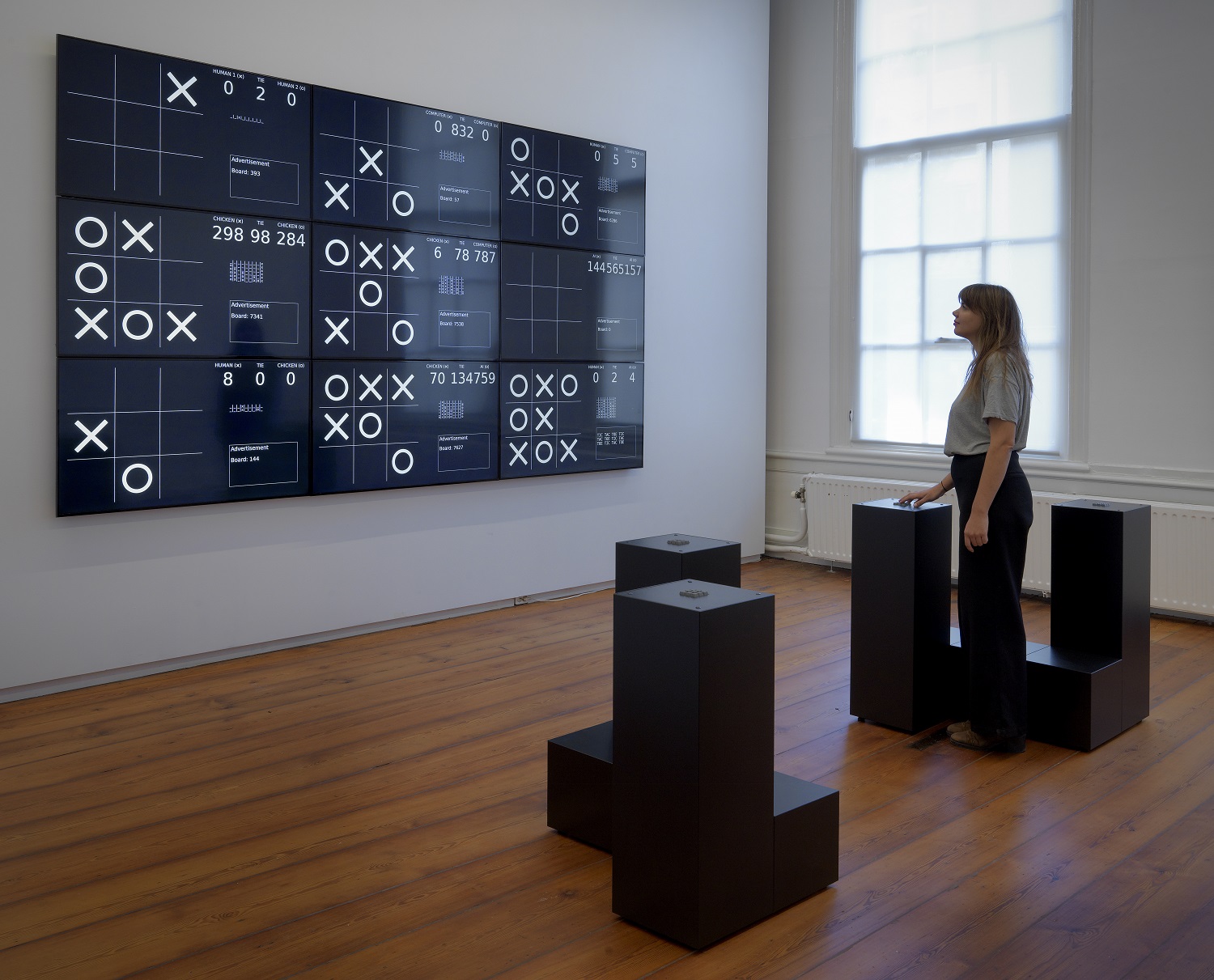Exhibition
Beyond AI – FARO Collection / Alfredo Jaar, Ryan Gander, JODI
August 14 - September 5, 2021
Collaboration: SCAI THE BATHHOUSE, TARO NASU, Takuro Someya Contemporary Art, Upstream Gallery

OXO
2018
Raspberry Pi 3, custom keypads, wood
Photo Gert Jan van Rooij.
Courtesy Upstream Gallery Amsterdam & the artists
Maki Fine Arts is pleased to present Beyond AI – FARO Collection, a three-artist show by Alfredo Jaar, Ryan Gander, and JODI, starting Saturday, August 14, through Sunday, September 5, 2021.
—
Toward a different relationship with the internet–Writing on the Beyond AI exhibition
By Shinya Sugawara (art critic / theory)
In the mid-1970s before the current-day AI existed, there was an arcade game called Bird Game in which a patron could play a game of Tic-Tac-Toe with a chicken. Of course, the chicken wasn’t the one actually playing the game. It was conditioned to peck on the lit-up buttons that were connected to the computer program which determined the appropriate move. JODI’s “OXO” is inspired by the Bird Game and includes four types of players: chickens, humans, computers, and AI. The title “OXO” comes from what is known as the world’s first computer game, OXO, created by Alexander S. Douglas in 1952. The news of the Alpha Go computer program developed by Google DeepMind beating Lee Se-dol, a world champion Go player, is still fresh in our mind, and the significance of the event is no doubt reflected in JODI’s 2018 work. JODI’s work, however, is completely unlike the distant world of champion-Go-player-vs.-enigmatic-AI. JODI’s “OXO” is an interactive work that allows visitors to play a game of Tic-Tac-Toe against four types of players. Through this simple game familiar to everyone, visitors are able to experience and gain close understanding of the history of computers and games.
Ryan Gander’s “On slow Obliteration, or Illusion of explanatory depth” is comprised of a black, box-like device and the text displayed adjacent to the device. The text includes the artist’s critical view on the objective of smart phones and social media–encouraging users to waste time–and how that wasted time is linked to monetary gain. Websites and social media sites are designed to guide the user’s line of sight to follow in a certain way in order to persuade seeing particular images and videos or to click a certain link. The goal of these sites is to make people spend time on the sites and to generate profit. In contrast, Gander’s work presents an alternative to the concept of devices and optical sensation, contrasting the way we tend to stare at a single point or to follow the guided visual path when viewing websites and social media sites. In other words, while Gander’s work appears similar to the dots found on smart phone LCD screens, it is created using a simple, analog system comprised of black and gold flip dots. In order for the viewer to be ready for the relatively random flipping motion, it becomes necessary to look at the entirety of the work, absent-mindedly and without clear purpose.
For the Beyond AI show, Alfredo Jaar’s “You Do Not Take a Photograph, You Make It” is only one piece, a framed poster. Originally, however, his work was accompanied by a lightbox and take-home posters. The phrase used for the work title came from photographer Ansel Adams. Decades after he uttered those words, the environment surrounding pictures and images have drastically changed. When read today, the meaning of the same phrase can be interpreted completely differently. In this day and age, practically anyone can easily manipulate photos and even create a completely fake image using computer programs or AI. By taking an Ansel Adam phrase and using it on a take-home poster, Jaar asks us to pay attention to the current state of photos and images as well as the changes taking place in the field, urging responsibility for those creating images.
None of the three works in Beyond AI necessarily rejects the significance or existence of the internet or AI. Rather, the works question our relationships toward them and encourage us to build a different connection through various methods. Whether or not we embrace these methods and how we do it is up to our behavior after leaving the exhibition.
[Simultaneous Exhibition]
Alex Dodge “Remote Working”
Date : August 14 – September 5, 2021
Venue : FARO Kagurazaka
For more information

